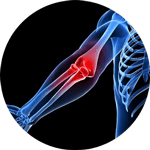
Prolotherapy Is a Lasting Treatment for Tennis Elbow
The article shows that patients improved with both Prolotherapy and Cortisone in the short-term. However, as we have discussed in previous articles, cortisone injections did not last in the long term. Here you will see that patients who received Prolotherapy, continued to improve at the 3 month follow-up. And those who received cortisone did not.
Purpose: To compare the efficacy of dextrose prolotherapy versus steroid injection in the treatment of patients with chronic lateral epicondylitis.
Methods: Thirty subjects with chronic lateral epicondylitis were randomly assigned into two groups of hypertonic dextrose or methylprednisolone injection. Participants were assessed through Quick DASH and VAS scores, once before injection, and then after 1- and 3-months follow-up. And two patients were excluded due to not completing the follow-up timepoints.
Results: In both groups VAS scores revealed significant improvement during the first month follow-up [mean difference (MD) = 1.9±3.3, versus 1.5±1.9 for the prolotherapy and steroid groups, respectively]. This declining trajectory continued at the third month visit in the prolotherapy group and MD reached 4.4±2.9, while it did not change remarkably in the steroid group (MD=1.9±3.4).
In fact, comparing VAS scores between the 1st- and 3rd-month time points did not reveal a significant improvement in the steroid group (p=0.6). Also, the Quick DASH index showed a similar pattern and improved remarkably in both groups during the first visit.
One month after injections no preference was observed between the two interventions (p=0.74 for VAS and 0.14 for Quick DASH score). However, the 3rd-month follow-up revealed a meaningful superiority (p=0.03 for VAS and p=0.01 for Quick DASH score) favoring the prolotherapy method.
Conclusion: Both methods were proven to be effective in the short-term treatment of chronic lateral epicondylitis, but dextrose prolotherapy seems to be slightly more efficacious than steroid injection over a longer period.